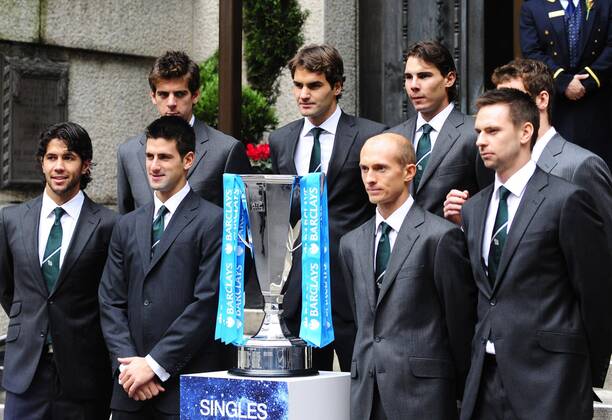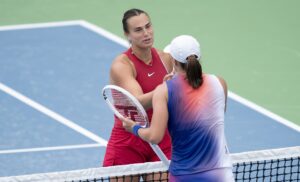The growth of men’s tennis globally was encapsulated with the rise of prestige of the ATP World Tour finals tournament, the ATP finals (sometimes known as the Masters Cup) launched in 1970, and spent 12 iconic years in New York City, as the first “golden generation” period saw Ivan Lendl win five singles titles to end the year, and America’s own John McEnroe win three. American Pete Sampras lifted five titles when the ATP Finals were in Germany, before Roger Federer began a run of six ATP Finals victories across three locations, with two titles each in Houston, Shanghai, and London. He was also on the short end of the final five set final in ATP finals history, a five set defeat to punchy Argentine shotmaker David Nalbandian in 2005 in Shanghai, a match that ended on a five set tiebreak.
When the ATP World Tour announced they would move the finals to London, the event began to rise in viewership and prestige, the ATP Masters series, and the Grand Slams have long been considered the cream of the crop when it comes to men’s tennis, offering the most prize money, points, and drawing the most fans on TV and to stadiums around the globe. The ATP Finals has a unique value proposition, as it is the only tournament with a small field that guarantees the best players (fitness permitting) that season will face each other over the course of a week in both singles and doubles. This means whether you buy a ticket to attend in person or watch a stream, you should be guaranteed to see the “best of the best” matchups, matchups that we are often denied in Grand Slams or Masters 1000s because seeding and upsets based on form often means that the most “elite matchups” are denied.
Despite that value proposition, the ATP Finals is struggling to attract attention from mainstream sports fans and even some tennis fans, especially since the “big four” of Rafael Nadal, Roger Federer, Novak Djokovic, and Andy Murray, has been reduced to just Djokovic, and Djokovic is not participating in this year’s ATP Finals. Fitness kept Djokovic out of this year’s ATP Finals, though he has dominated the last two editions held in Turin, Italy, winning both finals in straight sets.
Djokovic’s seven ATP finals trophies, a run he began in 2008, makes him the most accomplished player in the tournament’s history. Though fans of clay court stars like Rafael Nadal would rightly point out that for a tour that is played across four surfaces, the ATP Finals have consistently taken place at the years end on indoor hard courts, a surface that favors a specific playstyle. Djokovic and Roger Federer have been the record setters for this tournament, combining for 13 titles.
“The ATP World Tour Finals” era in London was the marquee period for this tournament, moving to an international showpiece city, with US TV Coverage on ESPN, and UK/Europe TV coverage on Sky Sports, fans were treated to a Federer vs Nadal final in 2010, Djokovic vs Federer, and Djokovic vs Nadal in 2012 and 2013, Djokovic vs Federer in 2015, and Andy Murray winning his only ATP Finals championship in 2016, when the Brit won at home against Djokovic. During this era, only Jo-Wilfried Tsonga in 2011, and the 2009 final between Nikolay Davydenko and Juan Martin Del Potro featured non big four players in the championship match of the ATP World Tour Finals in London. Del Potro, a former US Open Champion, very well could have made it “the big five” but wrist injuries destroyed the promise of his career.
2017 saw the “end of the big four” era, with Grigor Dimitrov edging David Goffin, and the now retired Dominic Thiem reached consecutive finals in 2019 and 2020.
The tournament’s move to Turin in Northern Italy, resulted in higher prize money, and it is Italy’s largest indoor sports arena, but what was lost, coinciding with the decline/retirement of the big four, was relevance in the global sporting calendar. For those who are not hardcore fans of the sport, the length of the ATP/WTA season is difficult to track, and casual fans of the sport begin to tune out with the conclusion of the US Open at the end of Summer. The ATP’s Asia swing is lucrative, and it’s European heartland gets to host a number of tournaments in the fall, but with exhibitions like the Six Kings Slam in Riyadh, and Laver Cup attracting some of the biggest names in the sport, the ATP Finals is declining in importance and isn’t producing as many marquee matchups.
Rather players look exhausted and ready for the season to end, with Daniil Medvedev notably melting down on court this week in frustration, and Djokovic declining to participate. Relegated to streaming services like Tennis TV and niche networks like Tennis Channel in the United States, the ATP Finals has little hope of broadening its audience beyond the core tennis fans worldwide and gamblers. Though there was one bright sign, with top player Jannik Sinner’s win against Alex de Minaur being aired on free to air tv in Italy and drawing more viewers than a Serie A clash featuring giants Napoli and Inter Milan.
The ATP’s next generation is talented, but only Alcaraz and Sinner have lifted Grand Slam titles in the last three years, this year Alcaraz and Sinner split the Grand Slam titles. While Andrey Rublev and Alexander Zverev both won Masters 1000 titles this season. Sponsorship revenue and visibility in the greater sporting universe has escaped this current set of eight ATP stars, as even Alcaraz and Sinner are not household names in the larger global sporting universe.
The dominance of Djokovic, Nadal, and less recently, Federer, for so long made it hard for tennis to find new stars, and now they may not be marketed in a way that showcases their talents and personalities. While Sinner in particular has been weighed down by a controversial doping case, and Russia’s war in Ukraine has made it difficult for Russian stars Rublev and Medvedev to achieve popular acclaim.
While moving back to London isn’t an option right now, the ATP World Tour needs to consider how to market their stars better, consider finally changing the surface for the ATP Finals to clay or carpet to create something more intriguing than yet another indoor hard court after ATP Paris and other tournaments take place, and perhaps most of all they need to shorten the core of the season. While smaller 250 level events should be able to place later in the year, wrapping up the Masters and Tour Finals events shortly after the US Open would create less conflict with the exhibition calendar, and give players more time for better fitness and rest, because the sport can only excel if its best players are on court, for its biggest tournaments, and those tournaments are drawing viewership.
All of this planning may not matter of course, if one of the ATP Next Gen finals young guns were to surge in form and become a new household name.
Main Image Credit: Copyright: Imago Images/Xinhua





